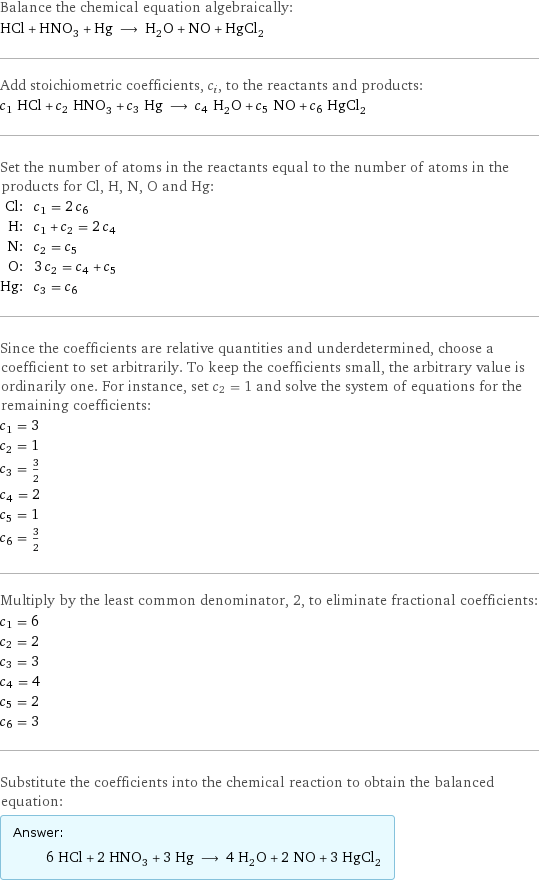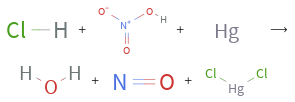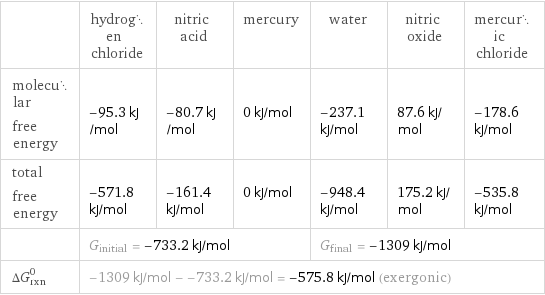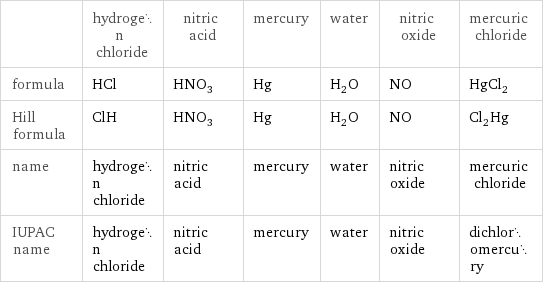Input interpretation

HCl hydrogen chloride + HNO_3 nitric acid + Hg mercury ⟶ H_2O water + NO nitric oxide + HgCl_2 mercuric chloride
Balanced equation

Balance the chemical equation algebraically: HCl + HNO_3 + Hg ⟶ H_2O + NO + HgCl_2 Add stoichiometric coefficients, c_i, to the reactants and products: c_1 HCl + c_2 HNO_3 + c_3 Hg ⟶ c_4 H_2O + c_5 NO + c_6 HgCl_2 Set the number of atoms in the reactants equal to the number of atoms in the products for Cl, H, N, O and Hg: Cl: | c_1 = 2 c_6 H: | c_1 + c_2 = 2 c_4 N: | c_2 = c_5 O: | 3 c_2 = c_4 + c_5 Hg: | c_3 = c_6 Since the coefficients are relative quantities and underdetermined, choose a coefficient to set arbitrarily. To keep the coefficients small, the arbitrary value is ordinarily one. For instance, set c_2 = 1 and solve the system of equations for the remaining coefficients: c_1 = 3 c_2 = 1 c_3 = 3/2 c_4 = 2 c_5 = 1 c_6 = 3/2 Multiply by the least common denominator, 2, to eliminate fractional coefficients: c_1 = 6 c_2 = 2 c_3 = 3 c_4 = 4 c_5 = 2 c_6 = 3 Substitute the coefficients into the chemical reaction to obtain the balanced equation: Answer: | | 6 HCl + 2 HNO_3 + 3 Hg ⟶ 4 H_2O + 2 NO + 3 HgCl_2
Structures

+ + ⟶ + +
Names

hydrogen chloride + nitric acid + mercury ⟶ water + nitric oxide + mercuric chloride
Reaction thermodynamics
Gibbs free energy

| hydrogen chloride | nitric acid | mercury | water | nitric oxide | mercuric chloride molecular free energy | -95.3 kJ/mol | -80.7 kJ/mol | 0 kJ/mol | -237.1 kJ/mol | 87.6 kJ/mol | -178.6 kJ/mol total free energy | -571.8 kJ/mol | -161.4 kJ/mol | 0 kJ/mol | -948.4 kJ/mol | 175.2 kJ/mol | -535.8 kJ/mol | G_initial = -733.2 kJ/mol | | | G_final = -1309 kJ/mol | | ΔG_rxn^0 | -1309 kJ/mol - -733.2 kJ/mol = -575.8 kJ/mol (exergonic) | | | | |
Entropy

| hydrogen chloride | nitric acid | mercury | water | nitric oxide | mercuric chloride molecular entropy | 187 J/(mol K) | 156 J/(mol K) | 76 J/(mol K) | 69.91 J/(mol K) | 211 J/(mol K) | 144 J/(mol K) total entropy | 1122 J/(mol K) | 312 J/(mol K) | 228 J/(mol K) | 279.6 J/(mol K) | 422 J/(mol K) | 432 J/(mol K) | S_initial = 1662 J/(mol K) | | | S_final = 1134 J/(mol K) | | ΔS_rxn^0 | 1134 J/(mol K) - 1662 J/(mol K) = -528.4 J/(mol K) (exoentropic) | | | | |
Equilibrium constant
![Construct the equilibrium constant, K, expression for: HCl + HNO_3 + Hg ⟶ H_2O + NO + HgCl_2 Plan: • Balance the chemical equation. • Determine the stoichiometric numbers. • Assemble the activity expression for each chemical species. • Use the activity expressions to build the equilibrium constant expression. Write the balanced chemical equation: 6 HCl + 2 HNO_3 + 3 Hg ⟶ 4 H_2O + 2 NO + 3 HgCl_2 Assign stoichiometric numbers, ν_i, using the stoichiometric coefficients, c_i, from the balanced chemical equation in the following manner: ν_i = -c_i for reactants and ν_i = c_i for products: chemical species | c_i | ν_i HCl | 6 | -6 HNO_3 | 2 | -2 Hg | 3 | -3 H_2O | 4 | 4 NO | 2 | 2 HgCl_2 | 3 | 3 Assemble the activity expressions accounting for the state of matter and ν_i: chemical species | c_i | ν_i | activity expression HCl | 6 | -6 | ([HCl])^(-6) HNO_3 | 2 | -2 | ([HNO3])^(-2) Hg | 3 | -3 | ([Hg])^(-3) H_2O | 4 | 4 | ([H2O])^4 NO | 2 | 2 | ([NO])^2 HgCl_2 | 3 | 3 | ([HgCl2])^3 The equilibrium constant symbol in the concentration basis is: K_c Mulitply the activity expressions to arrive at the K_c expression: Answer: | | K_c = ([HCl])^(-6) ([HNO3])^(-2) ([Hg])^(-3) ([H2O])^4 ([NO])^2 ([HgCl2])^3 = (([H2O])^4 ([NO])^2 ([HgCl2])^3)/(([HCl])^6 ([HNO3])^2 ([Hg])^3)](../image_source/e97e090c295b12b49d27b7982276948b.png)
Construct the equilibrium constant, K, expression for: HCl + HNO_3 + Hg ⟶ H_2O + NO + HgCl_2 Plan: • Balance the chemical equation. • Determine the stoichiometric numbers. • Assemble the activity expression for each chemical species. • Use the activity expressions to build the equilibrium constant expression. Write the balanced chemical equation: 6 HCl + 2 HNO_3 + 3 Hg ⟶ 4 H_2O + 2 NO + 3 HgCl_2 Assign stoichiometric numbers, ν_i, using the stoichiometric coefficients, c_i, from the balanced chemical equation in the following manner: ν_i = -c_i for reactants and ν_i = c_i for products: chemical species | c_i | ν_i HCl | 6 | -6 HNO_3 | 2 | -2 Hg | 3 | -3 H_2O | 4 | 4 NO | 2 | 2 HgCl_2 | 3 | 3 Assemble the activity expressions accounting for the state of matter and ν_i: chemical species | c_i | ν_i | activity expression HCl | 6 | -6 | ([HCl])^(-6) HNO_3 | 2 | -2 | ([HNO3])^(-2) Hg | 3 | -3 | ([Hg])^(-3) H_2O | 4 | 4 | ([H2O])^4 NO | 2 | 2 | ([NO])^2 HgCl_2 | 3 | 3 | ([HgCl2])^3 The equilibrium constant symbol in the concentration basis is: K_c Mulitply the activity expressions to arrive at the K_c expression: Answer: | | K_c = ([HCl])^(-6) ([HNO3])^(-2) ([Hg])^(-3) ([H2O])^4 ([NO])^2 ([HgCl2])^3 = (([H2O])^4 ([NO])^2 ([HgCl2])^3)/(([HCl])^6 ([HNO3])^2 ([Hg])^3)
Rate of reaction
![Construct the rate of reaction expression for: HCl + HNO_3 + Hg ⟶ H_2O + NO + HgCl_2 Plan: • Balance the chemical equation. • Determine the stoichiometric numbers. • Assemble the rate term for each chemical species. • Write the rate of reaction expression. Write the balanced chemical equation: 6 HCl + 2 HNO_3 + 3 Hg ⟶ 4 H_2O + 2 NO + 3 HgCl_2 Assign stoichiometric numbers, ν_i, using the stoichiometric coefficients, c_i, from the balanced chemical equation in the following manner: ν_i = -c_i for reactants and ν_i = c_i for products: chemical species | c_i | ν_i HCl | 6 | -6 HNO_3 | 2 | -2 Hg | 3 | -3 H_2O | 4 | 4 NO | 2 | 2 HgCl_2 | 3 | 3 The rate term for each chemical species, B_i, is 1/ν_i(Δ[B_i])/(Δt) where [B_i] is the amount concentration and t is time: chemical species | c_i | ν_i | rate term HCl | 6 | -6 | -1/6 (Δ[HCl])/(Δt) HNO_3 | 2 | -2 | -1/2 (Δ[HNO3])/(Δt) Hg | 3 | -3 | -1/3 (Δ[Hg])/(Δt) H_2O | 4 | 4 | 1/4 (Δ[H2O])/(Δt) NO | 2 | 2 | 1/2 (Δ[NO])/(Δt) HgCl_2 | 3 | 3 | 1/3 (Δ[HgCl2])/(Δt) (for infinitesimal rate of change, replace Δ with d) Set the rate terms equal to each other to arrive at the rate expression: Answer: | | rate = -1/6 (Δ[HCl])/(Δt) = -1/2 (Δ[HNO3])/(Δt) = -1/3 (Δ[Hg])/(Δt) = 1/4 (Δ[H2O])/(Δt) = 1/2 (Δ[NO])/(Δt) = 1/3 (Δ[HgCl2])/(Δt) (assuming constant volume and no accumulation of intermediates or side products)](../image_source/95822547e41e278a2074884ddb699c73.png)
Construct the rate of reaction expression for: HCl + HNO_3 + Hg ⟶ H_2O + NO + HgCl_2 Plan: • Balance the chemical equation. • Determine the stoichiometric numbers. • Assemble the rate term for each chemical species. • Write the rate of reaction expression. Write the balanced chemical equation: 6 HCl + 2 HNO_3 + 3 Hg ⟶ 4 H_2O + 2 NO + 3 HgCl_2 Assign stoichiometric numbers, ν_i, using the stoichiometric coefficients, c_i, from the balanced chemical equation in the following manner: ν_i = -c_i for reactants and ν_i = c_i for products: chemical species | c_i | ν_i HCl | 6 | -6 HNO_3 | 2 | -2 Hg | 3 | -3 H_2O | 4 | 4 NO | 2 | 2 HgCl_2 | 3 | 3 The rate term for each chemical species, B_i, is 1/ν_i(Δ[B_i])/(Δt) where [B_i] is the amount concentration and t is time: chemical species | c_i | ν_i | rate term HCl | 6 | -6 | -1/6 (Δ[HCl])/(Δt) HNO_3 | 2 | -2 | -1/2 (Δ[HNO3])/(Δt) Hg | 3 | -3 | -1/3 (Δ[Hg])/(Δt) H_2O | 4 | 4 | 1/4 (Δ[H2O])/(Δt) NO | 2 | 2 | 1/2 (Δ[NO])/(Δt) HgCl_2 | 3 | 3 | 1/3 (Δ[HgCl2])/(Δt) (for infinitesimal rate of change, replace Δ with d) Set the rate terms equal to each other to arrive at the rate expression: Answer: | | rate = -1/6 (Δ[HCl])/(Δt) = -1/2 (Δ[HNO3])/(Δt) = -1/3 (Δ[Hg])/(Δt) = 1/4 (Δ[H2O])/(Δt) = 1/2 (Δ[NO])/(Δt) = 1/3 (Δ[HgCl2])/(Δt) (assuming constant volume and no accumulation of intermediates or side products)
Chemical names and formulas

| hydrogen chloride | nitric acid | mercury | water | nitric oxide | mercuric chloride formula | HCl | HNO_3 | Hg | H_2O | NO | HgCl_2 Hill formula | ClH | HNO_3 | Hg | H_2O | NO | Cl_2Hg name | hydrogen chloride | nitric acid | mercury | water | nitric oxide | mercuric chloride IUPAC name | hydrogen chloride | nitric acid | mercury | water | nitric oxide | dichloromercury